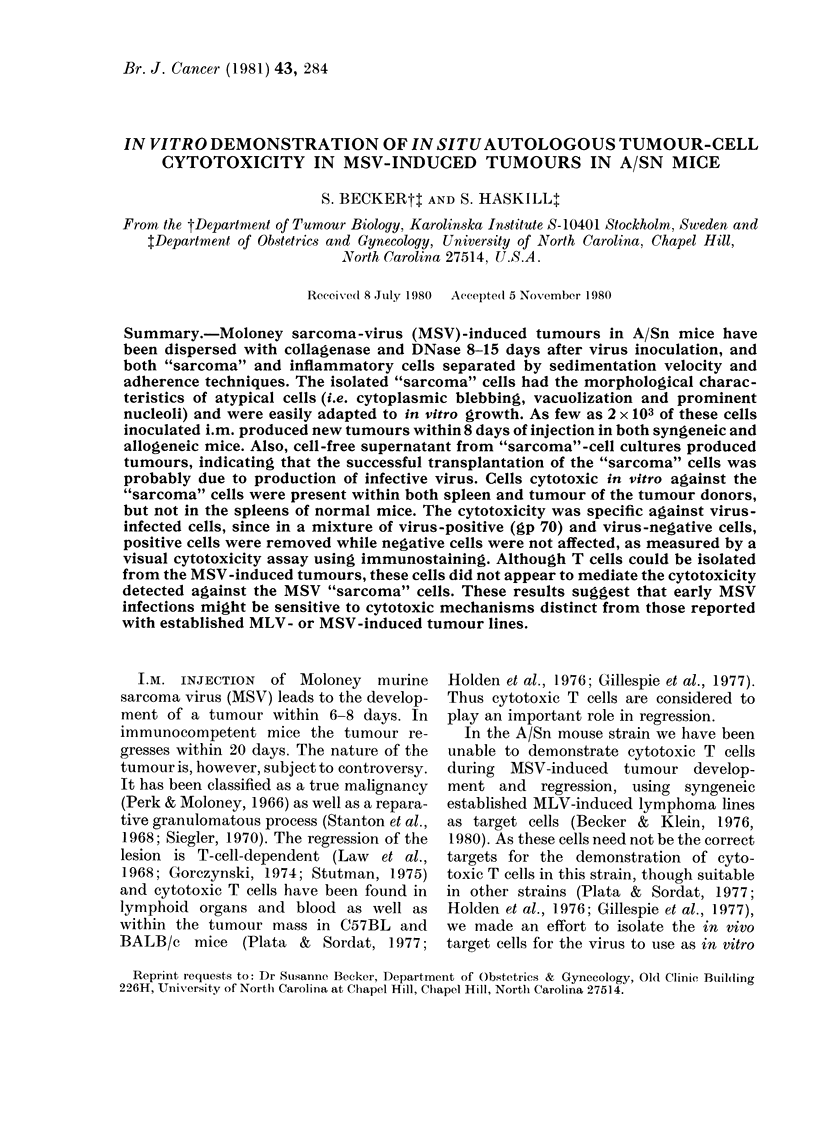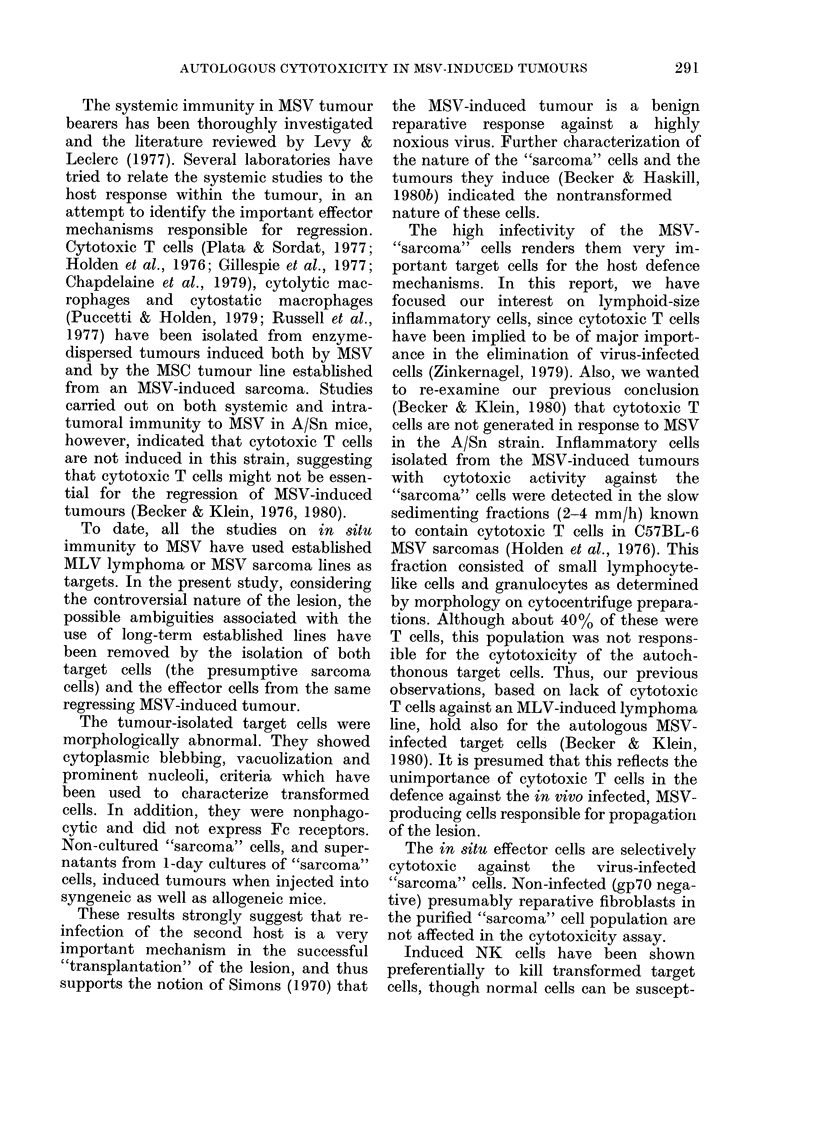Abstract
Moloney sarcoma-virus (MSV)-induced tumours in A/Sn mice have been dispersed with collagenase and DNase 8-15 days after virus inoculation, and both "sarcoma" and inflammatory cells separated by sedimentation velocity and adherence techniques. The isolated "sarcoma" cells had the morphological characteristics of atypical cells (i.e. cytoplasmic blebbing, vacuolization and prominent nucleoli) and were easily adapted to in vitro growth. As few as 2 x 10(3) of these cells inoculated i.m. produced new tumours within 8 days of injection in both syngeneic and allogeneic mice. Also, cell-free supernatant from "sarcoma"-cell cultures produced tumours, indicating that the successful transplantation of the "sarcoma" cells was probably due to production of infective virus. Cells cytotoxic in vitro against the "sarcoma" cells were present within both spleen and tumour of the tumour donors, but not in the spleens of normal mice. The cytotoxicity was specific against virus-infected cells, since in a mixture of virus-positive (gp 70) and virus-negative cells, positive cells were removed while negative cells were not affected, as measured by a visual cytotoxicity assay using immunostaining. Although T cells could be isolated from the MSV-induced tumours, these cells did not appear to mediate the cytotoxicity detected against the MSV "sarcoma" cells. These results suggest that early MSV infections might be sensitive to cytotoxic mechanisms distinct from those reported with established MLV- or MSV-induced tumour lines.
Full text
PDF









Images in this article
Selected References
These references are in PubMed. This may not be the complete list of references from this article.
- Becker S., Haskill S. Characterization of the presumptive sarcoma cells in primary MSV tumors. Int J Cancer. 1980 Apr 15;25(4):543–550. doi: 10.1002/ijc.2910250417. [DOI] [PubMed] [Google Scholar]
- Becker S., Haskill S. Non-T-cell-mediated cytotoxicity in MSV tumor-bearing mice. III. Macrophage-mediated cytotoxicity against autochthonous MSV tumor-isolated target cells. Int J Cancer. 1980 Apr 15;25(4):535–541. doi: 10.1002/ijc.2910250416. [DOI] [PubMed] [Google Scholar]
- Becker S., Klein E. Defective cytotoxic T-cell generation in Moloney murine sarcoma virus-infected A/Sn mice. J Natl Cancer Inst. 1980 Oct;65(4):811–816. doi: 10.1093/jnci/65.4.811. [DOI] [PubMed] [Google Scholar]
- Berman L. D., Allison A. C. Studies on Murine Sarcoma Virus; a morphological comparison of tumorigenesis by the Harvey and Moloney strains in mice, and the establishment of tumor cell lines. Int J Cancer. 1969 Nov 15;4(6):820–836. doi: 10.1002/ijc.2910040611. [DOI] [PubMed] [Google Scholar]
- Chapdelaine J. M., Plata F., Lilly F. Tumors induced by murine sarcoma virus contain precursor cells capable of generating tumor-specific cytolytic T lymphocytes. J Exp Med. 1979 Jun 1;149(6):1531–1536. doi: 10.1084/jem.149.6.1531. [DOI] [PMC free article] [PubMed] [Google Scholar]
- Chapes S. K., Tompkins W. A. Cytotoxic macrophages induced in hamsters by vaccinia virus: selective cytotoxicity for virus-infected targets by macrophages collected late after immunization. J Immunol. 1979 Jul;123(1):303–310. [PubMed] [Google Scholar]
- Gillespie G. Y., Hansen C. B., Hoskins R. G., Russell S. W. Inflammatory cells in solid murine neoplasms. IV. Cytolytic T lymphocytes isolated from regressing or progressing Moloney sarcomas. J Immunol. 1977 Aug;119(2):564–570. [PubMed] [Google Scholar]
- Goldman R., Hogg N. Enhanced susceptibility of virus-infected fibroblasts to cytostasis mediated by peritoneal exudate cells. J Immunol. 1978 Nov;121(5):1657–1663. [PubMed] [Google Scholar]
- Gorczynski R. M. Evidence for in vivo protection against murine-sarcoma virus-induced tumors by T lymphocytes from immune animals. J Immunol. 1974 Feb;112(2):533–539. [PubMed] [Google Scholar]
- Holden H. T., Haskill J. S., Kirchner H., Herberman R. B. Two functionally distinct anti-tumor effector cells isolated from primary murine sarcoma virus-induced tumors. J Immunol. 1976 Aug;117(2):440–446. [PubMed] [Google Scholar]
- Korn J. H., Haskill J. S., Holden H. T., Radov L. A., Ritter F. L. In situ Fc receptor-bearing cells in two murine tumors. I. Isolation and identification. J Natl Cancer Inst. 1978 Jun;60(6):1387–1390. doi: 10.1093/jnci/60.6.1387. [DOI] [PubMed] [Google Scholar]
- Leclerc J. C., Cantor H. T cell-mediated immunity to oncornavirus-induced tumors. II. Ability of different T cell sets to prevent tumor growth in vivo. J Immunol. 1980 Feb;124(2):851–854. [PubMed] [Google Scholar]
- Levy J. P., Leclerc J. C. The murine sarcoma virus-induced tumor: exception or general model in tumor immunology? Adv Cancer Res. 1977;24:1–66. doi: 10.1016/s0065-230x(08)61012-x. [DOI] [PubMed] [Google Scholar]
- Mason T. E., Phifer R. F., Spicer S. S., Swallow R. A., Dreskin R. B. An immunoglobulin-enzyme bridge method for localizing tissue antigens. J Histochem Cytochem. 1969 Sep;17(9):563–569. doi: 10.1177/17.9.563. [DOI] [PubMed] [Google Scholar]
- Miller R. G., Phillips R. A. Separation of cells by velocity sedimentation. J Cell Physiol. 1969 Jun;73(3):191–201. doi: 10.1002/jcp.1040730305. [DOI] [PubMed] [Google Scholar]
- Nunn M. E., Herberman R. B., Holden H. T. Natural cell-mediated cytotoxicity in mice against non-lymphoid tumor cells and some normal cells. Int J Cancer. 1977 Sep 15;20(3):381–387. doi: 10.1002/ijc.2910200309. [DOI] [PubMed] [Google Scholar]
- Perk K., Moloney J. B. Pathogenesis of a virus-induced rhabdomyosarcoma in mice. J Natl Cancer Inst. 1966 Nov;37(5):581–599. [PubMed] [Google Scholar]
- Plata F., Sordat B. Murine sarcoma virus (MSV)-induced tumors in mice. I. Distribution of MSV-immune cytolytic T lymphocytes in vivo. Int J Cancer. 1977 Feb 15;19(2):205–211. doi: 10.1002/ijc.2910190210. [DOI] [PubMed] [Google Scholar]
- Puccetti P., Holden H. T. Cytolytic and cytostatic anti-tumor activities of macrophages from mice injected with murine sarcoma virus. Int J Cancer. 1979 Jan 15;23(1):123–132. doi: 10.1002/ijc.2910230122. [DOI] [PubMed] [Google Scholar]
- Russell S. W., Gillespie G. Y., McIntosh A. T. Inflammatory cells in solid murine neoplasms. III. Cytotoxicity mediated in vitro by macrophages recovered from disaggregated regressing Moloney sarcomas. J Immunol. 1977 May;118(5):1574–1579. [PubMed] [Google Scholar]
- Siegler R. Pathogenesis of virus-induced murine sarcoma. I. Light microscopy. J Natl Cancer Inst. 1970 Jul;45(1):135–147. [PubMed] [Google Scholar]
- Simons P. J., McCully D. J. Pathologic and virologic studies of tumors induced in mice by two strains of murine sarcoma virus. J Natl Cancer Inst. 1970 Jun;44(6):1289–1303. [PubMed] [Google Scholar]
- Stanton M. F., Law L. W., Ting R. C. Some biologic, immunogenic, and morphologic effects in mice after infection with a murine sarcoma virus. II. Morphologic studies. J Natl Cancer Inst. 1968 May;40(5):1113–1129. [PubMed] [Google Scholar]
- Stutman O. Delayed tumour appearance and absence of regression in nude mice infected with murine sarcoma virus. Nature. 1975 Jan 10;253(5487):142–144. doi: 10.1038/253142a0. [DOI] [PubMed] [Google Scholar]
- Taylor R. B. Immune paralysis of thymus cells by bovine serum albumin. Nature. 1968 Nov 9;220(5167):611–611. doi: 10.1038/220611a0. [DOI] [PubMed] [Google Scholar]
- Welsh R. M., Jr, Zinkernagel R. M., Hallenbeck L. A. Cytotoxic cells induced during lymphocytic choriomeningitis virus infection of mice. II. "Specificities" of the natural killer cells. J Immunol. 1979 Feb;122(2):475–481. [PubMed] [Google Scholar]




